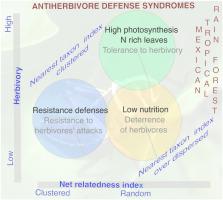Perspectives in Plant Ecology, Evolution and Systematics ( IF 3.5 ) Pub Date : 2020-12-05 , DOI: 10.1016/j.ppees.2020.125587 Betsabé Ruiz-Guerra , Alfonso García , Noé Velázquez-Rosas , Diego Angulo , Roger Guevara

|
A set of species, not linked by close ancestry, with similar functional responses to selective pressures, is known as a functional group or response syndrome. Some studies have investigated antiherbivore plant defenses in the context of defense syndromes, with contrasting results. We analyze how the assembly of leaf-functional traits and wood density can explain insect herbivory in 69 woody species in a tropical rain forest in southern Mexico. In addition, we used a phylogenetic hypothesis to address whether the observed syndromes were at least in part driven by ancestry. Three functional groups of woody plants were detected and related to 1) low nutritional quality, 2) resistance, and 3) tolerance to herbivory. Herbivory tolerant species presented the highest damage by herbivores, which is concordant with theoretical expectations and other empirical observations. In contrast, herbivory in the defensive resistance and low nutrition syndromes were 35 % and 55 % lower than in herbivory tolerant species, respectively. Taxa in the defensive resistance syndrome were significantly clustered based on the net relatedness index (NRI) and the nearest taxon index (NTI). In contrast, in the other two syndromes, the NRI showed a random structure but opposed deviations from random expectations in the NTI. Taxa in the low nutritional quality syndrome were over-dispersed in the phylogeny, while tolerant species appeared clustered. This evidence suggests that the low nutritional quality syndrome may represent the ancestral antiherbivore defense of woody plants in the tropical rain forest. In contrast, the tolerance and defensive resistance syndromes included clades of recent diversification.
中文翻译:

植物功能性状在热带雨林树木群落中驱食昆虫
一组没有紧密联系的物种,对选择压力具有相似的功能反应,被称为功能群或反应综合征。一些研究在防御综合症的背景下研究了抗草食性植物的防御作用,但结果却相反。我们分析了叶功能性状和木材密度的组合如何解释墨西哥南部热带雨林中69种木本植物的食草性。此外,我们使用了系统发育假说来解决观察到的综合症是否至少部分是由祖先驱动的。检测到三个木本植物功能组,它们与1)营养质量低,2)抗性和3)对草食动物的耐受性有关。食草耐受物种受到食草动物的损害最大,这与理论预期和其他经验观察相一致。相比之下,防御性和低营养综合症的草食性分别比耐草食性物种低35%和55%。防御抗性综合症中的分类单元基于净相关性指数(NRI)和最近的分类单元指数(NTI)显着聚集。相反,在其他两种综合症中,NRI显示出随机结构,但与NTI中的随机期望值背道而驰。低营养素质综合症的分类单元在系统发育中过度分散,而耐性物种则聚集。该证据表明,低营养质量综合症可能代表了热带雨林中木本植物的祖先抗草食动物防御能力。相反,









































 京公网安备 11010802027423号
京公网安备 11010802027423号